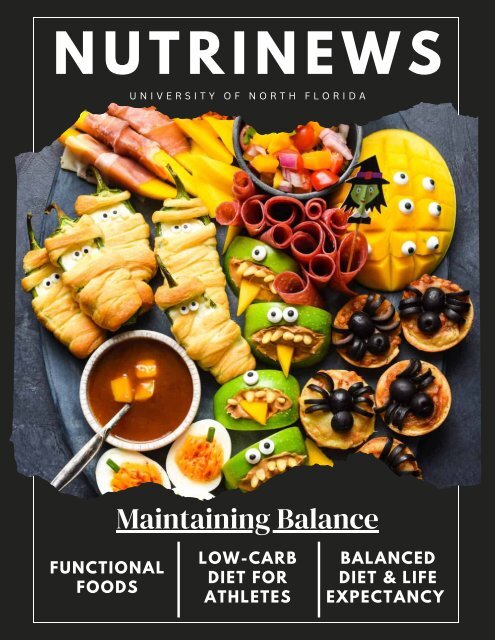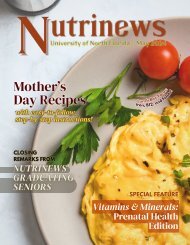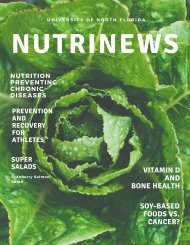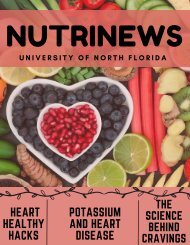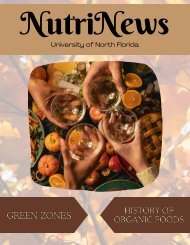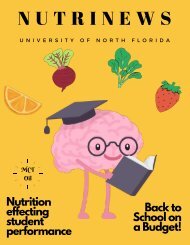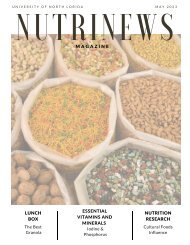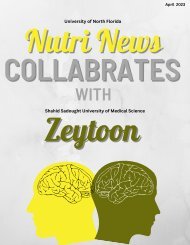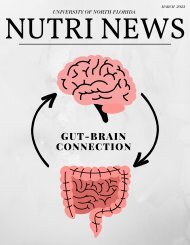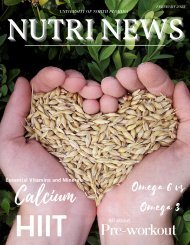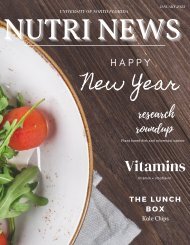October Issue 2023
Hello Readers! Finding and maintaining balance within our diets is always important, especially during this time of year. In this month's issue you can find information that discusses the importance of maintaining balance while still eating the foods and treats you love!
Hello Readers! Finding and maintaining balance within our diets is always important, especially during this time of year. In this month's issue you can find information that discusses the importance of maintaining balance while still eating the foods and treats you love!
You also want an ePaper? Increase the reach of your titles
YUMPU automatically turns print PDFs into web optimized ePapers that Google loves.
N U T R I N E W S<br />
U N I V E R S I T Y O F N O R T H F L O R I D A<br />
Maintaining Balance<br />
FUNCTIONAL<br />
FOODS<br />
LOW-CARB<br />
DIET FOR<br />
ATHLETES<br />
BALANCED<br />
DIET & LIFE<br />
EXPECTANCY
TABLE OF CONTENTS<br />
“BALANCE IS NOT SOMETHING YOU FIND, ITS<br />
SOMETHING YOU CREATE.” Jana Kingsford<br />
04.<br />
FUNCTIONAL FOODS<br />
A Guide Towards the Future: A<br />
Collaboration with Universidad de<br />
Guadalajara<br />
11.<br />
OKTOBERFEST<br />
Origin and Fun Facts<br />
12.<br />
18.<br />
SPORTS NUTRITION<br />
Low-Carb Diet on Athlete Performance<br />
MONTHLY HACKS<br />
How to Build a Balanced Meal<br />
21.<br />
LUNCH BOX<br />
Greek Lemon Chicken Soup<br />
22.<br />
NUTRITION RESEARCH<br />
Balanced Diet and Eating Habits on<br />
Life Expectancy<br />
STUDENT SPOTLIGHT<br />
26. Meet the Team<br />
NUTRINEWS STAFF<br />
30. Meet the Team
Rocío1, Arámbula Alexa1, Márquez-Sandoval<br />
Hernández-Ruiz<br />
Fabiola1,2<br />
Doctorado en Ciencias de la Nutrición Traslacional, Centro<br />
1<br />
de Ciencias de la Salud, Universidad de Guadalajara<br />
Universitario<br />
A GUIDE TOWARDS<br />
THE FUTURE<br />
FOODS:<br />
FUNCTIONAL<br />
4<br />
Licenciatura en Nutrición, Centro Universitario de Ciencias de la<br />
2<br />
Universidad de Guadalajara<br />
Salud,
YOU KNOW<br />
DID<br />
THAT?<br />
ancient times human society has believed in the healing properties of foods and this<br />
Since<br />
a reason for being, in addition to their nutritional qualities, some foods have<br />
has<br />
ARE FUNCTIONAL<br />
WHAT<br />
FOODS?<br />
functional food is a food or compound consumed as part of the regular diet, which has demonstrable health<br />
A<br />
beyond the basic nutritional: some basic functions of food are to provide energy for our daily activities,<br />
benefits<br />
support human survival and to offer a pleasant taste, texture and sensation2,3. The concept of functional food<br />
to<br />
in Japan in the 1980s due to the need to include food in the treatment and prevention of diseases4,5.<br />
originated<br />
about functional foods is a fashionable topic, so here are 4 points to help you recognize a real functional<br />
Talking<br />
and spend your money wisely:<br />
food<br />
the consumption of functional foods is becoming a necessity for health care, so to have a clear vision<br />
Currently<br />
will give you some options of functional foods that you surely have at your fingertips.<br />
we<br />
AND VEGETABLES: PHENOLIC<br />
FRUITS<br />
COMPOUNDS<br />
we had to choose a group of foods to establish themselves as the best functional foods, surely, they would be<br />
If<br />
and vegetables, as they are diverse in shapes, flavors and colors, this diversity of colors is given by phenolic<br />
fruits<br />
which are substances known for their antioxidant properties and health benefits, blackberries,<br />
compounds,<br />
tomatoes, green leafy vegetables are examples of foods high in these compounds. It is estimated<br />
strawberries,<br />
a high percentage of diseases can be prevented by increasing the consumption of fruits and vegetables as<br />
that<br />
of the daily diet7.<br />
part<br />
high consumption of fruits and vegetables is associated with a lower risk of non-communicable diseases, such<br />
A<br />
cancer, cardiovascular disease, and diabetes. Evidence points to phenolic compounds as responsible for<br />
as<br />
benefits, as they have been shown to decrease inflammation, the main trigger for other diseases7,8.<br />
health<br />
has also been shown that including fruits and vegetables in a regular diet improves microvascular function<br />
It<br />
general, including 5 servings per day (400 g)<br />
In<br />
positive benefits on health.<br />
has<br />
evidence indicates that 7.5 servings<br />
Scientific<br />
day (600 g) is recommended to reduce the<br />
per<br />
TIP:<br />
serving of fruit is: 1 red apple, ½<br />
1<br />
½ banana or 1 cup of your<br />
pear,<br />
chopped fruit. 1 serving of<br />
favorite<br />
is: 1 cup of raw<br />
vegetables<br />
(carrots, broccoli,<br />
vegetables<br />
components that classify them as functional foods1.<br />
effect on health must have scientific evidence to support it.<br />
1. The<br />
its consumption is safe and does not cause any kind of harm to the human being.<br />
2. That<br />
its ingredients are nutritionally adequate, i.e., that it does not contain excess sugar, salt, trans fat, etc.<br />
3. That<br />
are quality tests, shelf life and previous analysis methods6.<br />
4. There<br />
BENEFITS<br />
(predictor of cardiovascular disease) and decreases the risk of stroke8,9.<br />
How much should we consume per day?<br />
of cancer, while for coronary heart disease,<br />
risk<br />
cardiovascular disease and all-cause<br />
stroke,<br />
the lowest risk was observed with 10<br />
mortality,<br />
per day (800 g) 3,12.<br />
servings<br />
etc.) or 2 cups of green<br />
chayote,<br />
vegetables (spinach, chard,<br />
leafy<br />
lettuce)10.<br />
5
oil is an important part of different types of diet and is classified in the fat group which is<br />
Olive<br />
composed of monounsaturated fatty acids (MUFAs). On the other hand, seeds, such as<br />
mainly<br />
oil has shown to have different health benefits, especially in the treatment and prevention of<br />
Olive<br />
diseases, improving blood pressure, triglycerides, and cholesterol levels, thanks to the MUFAs<br />
cardiovascular<br />
polyunsaturated fatty acids (PUFAs) that make up these foods12. It has been shown that consuming<br />
and<br />
(nuts) instead of high-fat foods (meat, sausages, pastries) improves diastolic blood pressure, which is<br />
seeds<br />
addition, the phenolic compounds (remember them from the fruits and vegetables section) present in olive oil<br />
In<br />
metabolic control and hormonal profile in patients living with type 2 diabetes and overweight, which<br />
improve<br />
However, you can start by including a<br />
health11,13.<br />
(15 mL) and increase the amount little by little.<br />
tablespoon<br />
throughout the day. You can also<br />
them<br />
the seeds with other foods such as<br />
integrate<br />
very easy and delicious to consume.<br />
be<br />
for seeds, it has been shown that consuming 57<br />
As<br />
99 grams per day of nuts has positive effects on<br />
to<br />
health14.<br />
cardiovascular<br />
OIL AND SEEDS: HEALTHY<br />
OLIVE<br />
ACIDS<br />
FATTY<br />
walnuts or almonds, are the fruit of plants and are considered foods of high nutritional value11.<br />
BENEFITS<br />
considered a cardioprotective effect, that is, it prevents long-term damage to the cardiovascular system.<br />
translates into better quality of life and control of the disease13.<br />
much should we consume per day?<br />
How<br />
mL of olive oil showed to have an effect on<br />
25<br />
TIP:<br />
raw olive oil as a dressing in salads, so it will<br />
Include<br />
TIP:<br />
a serving of seeds with you and consume<br />
Take<br />
yogurt, salads, etc.<br />
6
one of the most consumed beverages in the world6 for its delicious and hypnotizing taste. For<br />
Coffee,<br />
you can never miss a good cup of coffee in the morning. For it to reach our table it goes through a<br />
sure<br />
of processes and changes, such as roasting and grinding, in this way we take advantage of all its<br />
series<br />
benefits15.<br />
the other hand, another beverage that is consumed worldwide is green tea. As coffee it has<br />
On<br />
properties and thanks to this it plays a relevant role in prevention and treatment of different<br />
antioxidant<br />
diseases such as obesity, type 2 diabetes mellitus, dyslipidemias, and cardiovascular<br />
metabolic<br />
diseases16.<br />
has been demonstrated that with regular coffee consumption there is a faster response in vigilance and<br />
It<br />
tasks, as well as in the processing of visual information15. It is also associated with a lower risk<br />
alertness<br />
developing prostate, endometrial, skin and liver cancer. And in other metabolic diseases such as type<br />
of<br />
diabetes, metabolic syndrome, gout, gallstones, and kidney stones17.<br />
2<br />
the other hand, it has been seen that the frequent use of coffee and green tea reduces fat mass,<br />
On<br />
mass index (BMI) and waist circumference, which improves overweight and obesity rates16,18. In<br />
body<br />
much should we<br />
How<br />
per day?<br />
consume<br />
is recommended<br />
Coffee<br />
1 to a maximum of 4<br />
from<br />
per day, to enjoy its<br />
cups<br />
benefits15,17,18.<br />
for green tea, scientific<br />
As<br />
tells us that a<br />
evidence<br />
of 434 mL is<br />
consumption<br />
which is<br />
recommended,<br />
to two cups per<br />
equivalent<br />
day16.<br />
in the morning,<br />
coffee<br />
your<br />
accompany<br />
good digestive, drink<br />
a<br />
after your meals.<br />
it<br />
AND GREEN TEA:<br />
COFFEE<br />
ANTIOXIDANTS<br />
BENEFITS<br />
addition, green tea helps reduce the incidence of diabetes and lowers LDL cholesterol levels19.<br />
TIP:<br />
can include your<br />
You<br />
meals.<br />
TIP:<br />
green tea can be<br />
Your<br />
7
are obtained through the diet. The intestinal microbiota is responsible for fermenting<br />
These<br />
carbohydrates, and the result of this process are called prebiotics, which<br />
non-digestible<br />
multiple benefits. Cereals are the main source of dietary fiber, but you can also get<br />
confer<br />
from fruits and vegetables20.<br />
them<br />
has been scientifically proven that a frequent consumption of dietary fiber reduces BMI, body<br />
It<br />
and body fat, fasting glucose and fasting insulin20, in patients with overweight, obesity<br />
weight<br />
even metabolic diseases such as metabolic syndrome. In addition, when you regularly<br />
and<br />
foods rich in fiber, they help you increase the feeling of satiety, less desire to eat sweet,<br />
consume<br />
and fatty foods, it also induces a feeling of preferring foods rich in prebiotics in your daily<br />
salty,<br />
life21,22.<br />
much should be<br />
How<br />
per day?<br />
consumed<br />
evidence says that an<br />
Scientific<br />
from 15 to 34 g of fiber<br />
intake<br />
an adequate amount to<br />
is<br />
its benefits. There is no<br />
obtain<br />
source of fiber, they are<br />
single<br />
very versatile and can be<br />
often<br />
with other foods or<br />
combined<br />
ingredients20,23.<br />
fiber and that you should<br />
in<br />
in your meals are<br />
include<br />
pears, apples<br />
raspberries,<br />
skin, broccoli,<br />
with<br />
sunflower<br />
cauliflower,<br />
chia, almonds,<br />
seeds,<br />
or nuts, try to<br />
walnuts,<br />
them in all your<br />
include<br />
FIBER: PREBIOTICS<br />
BENEFITS<br />
TIP:<br />
foods that are highest<br />
The<br />
meals throughout the day.<br />
8
summarize, functional foods are those that provide important nutrients that can help to protect you against<br />
To<br />
they should be consumed on a regular basis and thus take full advantage of their benefits,<br />
diseases,<br />
this article we present 4 different groups of functional foods that are within everyone's reach and that also<br />
In<br />
multiple benefits: coffee and green tea, with their antioxidant capacity that prevent cancer development<br />
have<br />
symptoms related to metabolic diseases6. Fruits and vegetables, high in phenolic compounds with their<br />
and<br />
capacity, improve health and prevent metabolic diseases7,8.<br />
antioxidant<br />
oil and seeds, belonging to the group of fatty acids, are responsible for improving blood pressure and<br />
Olive<br />
a protective effect. And, finally, fiber and prebiotics, which are excellent allies against diseases such as<br />
creating<br />
Bibliography<br />
Serafini M, Peluso I. Functional Foods for Health: The Interrelated Antioxidant and Anti-Inflammatory Role of Fruits, Vegetables, Herbs, Spices and Cocoa in Humans. Curr<br />
1.<br />
Des. 2016;22(44):6701-6715. doi:10.2174/1381612823666161123094235<br />
Pharm<br />
Granado-Lorencio F, Hernández-Alvarez E. Functional Foods and Health Effects: A Nutritional Biochemistry Perspective. Curr Med Chem. 2016;23(26):2929-2957.<br />
2.<br />
doi:10.2174/0929867323666160615105746<br />
Alkhatib A, Tsang C, Tiss A, et al. Functional Foods and Lifestyle Approaches for Diabetes Prevention and Management. Nutrients. 2017;9(12):1310.<br />
3.<br />
doi:10.3390/nu9121310<br />
Iwatani S, Yamamoto N. Functional food products in Japan: A review. Food Science and Human Wellness. 2019;8(2):96-101. doi:10.1016/j.fshw.2019.03.011<br />
4.<br />
Henry CJ. Functional foods. Eur J Clin Nutr. 2010;64(7):657-659. doi:10.1038/ejcn.2010.101<br />
5.<br />
Yamada K, Sato-Mito N, Nagata J, Umegaki K. Health Claim Evidence Requirements in Japan12. The Journal of Nutrition. 2008;138(6):1192S-1198S.<br />
6.<br />
doi:10.1093/jn/138.6.1192S<br />
Aune D, Giovannucci E, Boffetta P, et al. Fruit and vegetable intake and the risk of cardiovascular disease, total cancer and all-cause mortality—a systematic review and dose-<br />
7.<br />
meta-analysis of prospective studies. Int J Epidemiol. 2017;46(3):1029-1056. doi:10.1093/ije/dyw319<br />
response<br />
Duthie SJ, Duthie GG, Russell WR, et al. Effect of increasing fruit and vegetable intake by dietary intervention on nutritional biomarkers and attitudes to dietary change: a<br />
8.<br />
trial. Eur J Nutr. 2018;57(5):1855-1872. doi:10.1007/s00394-017-1469-0<br />
randomised<br />
Noad RL, Rooney C, McCall D, et al. Beneficial effect of a polyphenol-rich diet on cardiovascular risk: a randomised control trial. Heart. 2016;102(17):1371-1379.<br />
9.<br />
doi:10.1136/heartjnl-2015-309218<br />
FoodData Central. Accessed May 26, <strong>2023</strong>. https://fdc.nal.usda.gov/fdc-app.html#/<br />
10.<br />
George ES, Marshall S, Mayr HL, et al. The effect of high-polyphenol extra virgin olive oil on cardiovascular risk factors: A systematic review and meta-analysis. Crit Rev Food<br />
11.<br />
Nutr. 2019;59(17):2772-2795. doi:10.1080/10408398.2018.1470491<br />
Sci<br />
Fernández-Castillejo S, Pedret A, Catalán Ú, et al. Virgin Olive Oil Phenolic Compounds Modulate the HDL Lipidome in Hypercholesterolaemic Subjects: A Lipidomic<br />
12.<br />
of the VOHF Study. Mol Nutr Food Res. 2021;65(9):e2001192. doi:10.1002/mnfr.202001192<br />
Analysis<br />
Santangelo C, Filesi C, Varì R, et al. Consumption of extra-virgin olive oil rich in phenolic compounds improves metabolic control in patients with type 2 diabetes mellitus: a<br />
13.<br />
involvement of reduced levels of circulating visfatin. J Endocrinol Invest. 2016;39(11):1295-1301. doi:10.1007/s40618-016-0506-9<br />
possible<br />
Tindall AM, Petersen KS, Skulas-Ray AC, Richter CK, Proctor DN, Kris-Etherton PM. Replacing Saturated Fat With Walnuts or Vegetable Oils Improves Central Blood<br />
14.<br />
and Serum Lipids in Adults at Risk for Cardiovascular Disease: A Randomized Controlled-Feeding Trial. J Am Heart Assoc. 2019;8(9):e011512.<br />
Pressure<br />
doi:10.1161/JAHA.118.011512<br />
Haskell-Ramsay CF, Jackson PA, Forster JS, Dodd FL, Bowerbank SL, Kennedy DO. The Acute Effects of Caffeinated Black Coffee on Cognition and Mood in Healthy<br />
15.<br />
and Older Adults. Nutrients. 2018;10(10):1386. doi:10.3390/nu10101386<br />
Young<br />
Lin Y, Shi D, Su B, et al. The effect of green tea supplementation on obesity: A systematic review and dose-response meta-analysis of randomized controlled trials. Phytother<br />
16.<br />
2020;34(10):2459-2470. doi:10.1002/ptr.6697<br />
Res.<br />
Poole R, Kennedy OJ, Roderick P, Fallowfield JA, Hayes PC, Parkes J. Coffee consumption and health: umbrella review of meta-analyses of multiple health outcomes. BMJ.<br />
17.<br />
doi:10.1136/bmj.j5024<br />
2017;359:j5024.<br />
Watanabe T, Kobayashi S, Yamaguchi T, Hibi M, Fukuhara I, Osaki N. Coffee Abundant in Chlorogenic Acids Reduces Abdominal Fat in Overweight Adults: A Randomized,<br />
18.<br />
Controlled Trial. Nutrients. 2019;11(7):1617. doi:10.3390/nu11071617<br />
Double-Blind,<br />
Liu W, Wan C, Huang Y, Li M. Effects of tea consumption on metabolic syndrome: A systematic review and meta-analysis of randomized clinical trials. Phytother Res.<br />
19.<br />
doi:10.1002/ptr.6731<br />
2020;34(11):2857-2866.<br />
Hiel S, Bindels LB, Pachikian BD, et al. Effects of a diet based on inulin-rich vegetables on gut health and nutritional behavior in healthy humans. Am J Clin Nutr.<br />
20.<br />
doi:10.1093/ajcn/nqz001<br />
2019;109(6):1683-1695.<br />
Tomé-Castro XM, Rodriguez-Arrastia M, Cardona D, Rueda-Ruzafa L, Molina-Torres G, Roman P. Probiotics as a therapeutic strategy in obesity and overweight: a<br />
21.<br />
scientifically proven1.<br />
overweight and obesity along with any of their complications 20–23.<br />
In short, these are foods that should be in your regular diet from today, what do you think?<br />
review. Benef Microbes. 2021;12(1):5-15. doi:10.3920/BM2020.0111<br />
systematic<br />
Perna S, Ilyas Z, Giacosa A, et al. Is Probiotic Supplementation Useful for the Management of Body Weight and Other Anthropometric Measures in Adults Affected by<br />
22.<br />
and Obesity with Metabolic Related Diseases? A Systematic Review and Meta-Analysis. Nutrients. 2021;13(2):666. doi:10.3390/nu13020666<br />
Overweight<br />
Thompson SV, Hannon BA, An R, Holscher HD. Effects of isolated soluble fiber supplementation on body weight, glycemia, and insulinemia in adults with overweight and<br />
23.<br />
9<br />
obesity: a systematic review and meta-analysis of randomized controlled trials. Am J Clin Nutr. 2017;106(6):1514-1528. doi:10.3945/ajcn.117.163246
Breast Cancer<br />
Awareness<br />
Month<br />
1 in 8 women will develop breast cancer<br />
https://www.breastcancer.org/facts-statistics
Oktoberfest<br />
Origin<br />
Oktoberfest is an annual<br />
festival in Munich,<br />
Bavaria, Germany. The<br />
festival was in<br />
celebration of a royal<br />
marriage in <strong>October</strong> 12,<br />
1810. The honored<br />
couple was Kronprinz<br />
Ludwig (king) married the<br />
Princess Therese of<br />
Saxe-Hildburghausen in<br />
Munich.<br />
Thompson AR, Thompson AR. What exactly is Oktoberfest? Home & Garden Information<br />
Center | Clemson University, South Carolina. September 28, 2022. Accessed September<br />
29, <strong>2023</strong>. https://hgic.clemson.edu/what-exactly-isoktoberfest/#:~:text=Oktoberfest%20is%20an%20annual%20festival,of%20Saxe%2DHild<br />
burghausen%20in%20Munich.<br />
Fun Facts<br />
locals know the event as<br />
‘Wiesn’.<br />
Oktoberfest was not<br />
originally a beer festival<br />
but a celebration of a<br />
wedding.<br />
6 million people go a<br />
year.<br />
1.8 million gallons of<br />
beer is consumed there.<br />
Oktoberfest starts when<br />
the mayor taps the first<br />
keg<br />
Based on the<br />
attendance of 2016, the<br />
food included: 109 oxen,<br />
58 calves, 140,000+<br />
pairs of pork sausages,<br />
and 44,000 fish.<br />
12 fun facts you might not know<br />
about Oktoberfest. St Christopher’s<br />
Inns. Accessed September 29, <strong>2023</strong>.<br />
https://www.stchristophers.co.uk/travel-blog/funfacts-you-might-not-know-aboutoktoberfest/.<br />
11
SPORTS NUTRITION<br />
ATHLETES<br />
BALANCING CARBS<br />
IN THEIR DIETS<br />
By: Andrea Butler<br />
12<br />
Over the years, endurance athletes have been encouraged to adopt a high<br />
carbohydrate (HC) diet to provide their bodies with glucose to convert into<br />
energy during their exercise period. 1 However, recent reports demonstrate<br />
that endurance athletes can consume a low carbohydrate (LC) diet to increase<br />
oxidation of fat stores and relieve dependency on glucose stores. 1 LC diets<br />
are subdivided into low and very low or ketogenic, based on if the individual’s<br />
carbohydrate intake is less than 26% (130g) or less than 10% (20-50g) of<br />
total calories, respectively. 2 In individuals consuming LC diets, there is a<br />
shift in energy source, which is provided by fats and proteins. For instance,<br />
the LC diet is categorized as consuming >75% of energy from fat, 1.76-2.2g<br />
of protein per kg of lean mass, and
To produce energy, ketones are formed in response to fatty acids being<br />
released into the bloodstream, meaning that energy usage has shifted to the<br />
muscles and liver. 2 Some researchers claim that high levels of circulating<br />
ketone bodies can help athletes during moderate-low intensity activities, as<br />
fat is the major fuel source during submaximal exercise. 3 In addition,<br />
shifting away from utilizing glycogen to unlimited fat stores prevents muscle<br />
glycogen depletion and early stages of exercise fatigue. 3<br />
Wachsmuth et al conducted a single center, non-randomized cross over trial<br />
to compare the effects of a HC diet and a LC diet on physical performance. 2<br />
Participants were 18-41 year olds who had normal nutrition behaviors and<br />
body mass indexes between 18-27 kg/m 2 . The participants first followed a<br />
HC diet for three weeks that was achieved with complex carbohydrates, and<br />
then they had a three-week washout period. Next, the participants engaged<br />
in one week of a LC diet leading to a two-week ketogenic diet with instruction<br />
from nutritionists. During this time, the control group did not adhere to any<br />
nutritional advice. After the three weeks of HC eating and LC/keto eating, the<br />
researchers measured aerobic performance by gathering data from a cardiopulmonary<br />
exercise test to determine parameters like VO 2peak , P peak, and<br />
oxygen efficiency. Other parameters measured included resting metabolic<br />
rate, body composition, daily physical activity, total cholesterol, LDL<br />
cholesterol, and blood samples.<br />
CARBS<br />
FAT &<br />
PROTEIN<br />
13
The results for VO 2peak showed a<br />
higher peak performance, longer<br />
exhaustion time, and greater Watt/kg (W)<br />
performance for the HC diet intervention.<br />
In addition, P peak was significantly<br />
higher in the HC arm, with 251 ± 43 W<br />
compared to 240 ± 40 W in the LC arm.<br />
Since there was a higher P peak in the<br />
HC arm, oxygen consumption per W was<br />
higher after the LC diet compared to the<br />
HC diet at 250 W and at exhaustion.<br />
Furthermore, total cholesterol and LDL<br />
cholesterol levels were significantly<br />
reduced after the HC diet. Overall, the<br />
data indicates that the HC diet resulted in<br />
the most positive changes within various<br />
markers of exercise performance, which<br />
was shown by higher P peak and time-toexhaustion<br />
(TTE) levels. 2<br />
In comparison, Shaw et al investigated<br />
the effects of the ketogenic diet (KD) on<br />
submaximal exercise capacity and<br />
efficiency. 4 The researchers performed a<br />
randomized, crossover trial with 8 trained<br />
endurance male athletes. For a period of<br />
31 days, the researchers separated the<br />
participants into two groups: one<br />
following a carbohydrate-based diet<br />
(CBD) of 43% total carbohydrates and<br />
38% total fat and the other following a KD<br />
with 4% total carbohydrates and 78%<br />
total fat. On the 2 nd and 29 th days of<br />
the trial, the participants performed a<br />
fasted metabolic test and a run-toexhaustion<br />
trial at 70% VO 2 max. In<br />
addition, the researchers measured<br />
respiratory exchange ratio (RER), VO 2<br />
max, TTE, and dietary adaptations for pre<br />
and post KD and CBD groups.<br />
Training loads held similar results<br />
between the metabolic test and run trial,<br />
showing an unchanged level of VO 2 max.<br />
Although exercise efficiency for the KD<br />
group was maintained at
Although the KD and LC diet have majority<br />
rule within the athletic community, there<br />
are dietary requirements established by the<br />
American Dietetic Association to ensure<br />
that an athlete’s food intake provides<br />
adequate nutrients to meet the physical<br />
demands of their exercise. 5 The<br />
requirements are dependent upon intensity,<br />
duration, frequency, and gender, and there<br />
are several instances where athletes<br />
significantly underestimate their energy and<br />
carbohydrate needs. It is especially<br />
concerning when an athlete who already<br />
underestimates their energy requirements<br />
decides to adopt a KD or LC diet, as doing<br />
so may pose a danger to their health.<br />
Therefore, having a balanced diet of<br />
protein, carbohydrates, and fat is important<br />
to provide the energy needed for an athlete<br />
to reach optimal training and performance<br />
at a safe standard. In addition, a balance of<br />
macronutrients decreases the risk of injury<br />
and immediate fatigue.<br />
Regarding carbohydrates, this<br />
macronutrient is an athlete’s main source of<br />
immediate energy and can prolong<br />
depletion of glycogen stores if the<br />
carbohydrate level is high at the start of the<br />
exercise. Consequently, a low amount of<br />
carbohydrates at the beginning of an<br />
exercise has the ability to cause a<br />
nutritional imbalance, particularly if the<br />
importance of macronutrients is not well<br />
comprehended. As Jagim et al explained,<br />
one reason athletes fail to meet their<br />
nutritional requirements is due to a lack of<br />
sports nutrition education. This knowledge<br />
gap stems from an absence of nutrition<br />
awareness within the athletic community<br />
regarding the higher energy and<br />
macronutrient intakes needed to meet the<br />
physical demands of several sports. Food<br />
intake should be specific to the individual<br />
and the level of intensity at which they<br />
perform, as well as include dietary<br />
strategies that monitor which foods benefit<br />
or hinder an athlete’s exercise capacity. 5<br />
References<br />
1. McSwiney FT, Wardrop B, Hyde PN, Lafountain RA, Volek JS, Doyle L. Keto-adaptation enhances exercise performance and body<br />
composition responses to training in endurance athletes. Metabolism. 2018;81:25-34. doi:10.1016/j.metabol.2017.10.010<br />
2. Wachsmuth NB, Aberer F, Haupt S, et al. The Impact of a High-Carbohydrate/Low Fat vs. Low-Carbohydrate Diet on Performance<br />
and Body Composition in Physically Active Adults: A Cross-Over Controlled Trial. Nutrients. 2022;14(3):423-.<br />
doi:10.3390/nu14030423<br />
3. Carr AJ, Sharma AP, Ross ML, Welvaert M, Slater GJ, Burke LM. Chronic Ketogenic Low Carbohydrate High Fat Diet Has Minimal<br />
Effects on Acid-Base Status in Elite Athletes. Nutrients. 2018;10(2):236-. doi:10.3390/nu100<strong>2023</strong>6<br />
4. Shaw DM, Merien F, Braakhuis A, Mauder E, Dulson DK. Effect of a Ketogenic Diet on Submaximal Exercise Capacity and Efficiency<br />
in Runners. Med Sci Sports Exerc. 2019;51(10):2135-2146. doi:10.1249/MSS.0000000000002008<br />
5. Jagim AR, Fields JB, Magee M, et al. The Influence of Sport Nutrition Knowledge on Body Composition and Perceptions of Dietary<br />
Requirements in Collegiate Athletes. Nutrients. 2021;13(7):2239-. doi:10.3390/nu13072239<br />
15
Health<br />
Health<br />
Mental Day Day<br />
World<br />
World<br />
<strong>October</strong> 10th, <strong>2023</strong>
How to Build a<br />
Balanced Meal<br />
Choose a variety of foods at each<br />
meal, especially foods that are from<br />
at least 3 of the MyPlate food<br />
groups.<br />
Consume a variety of fruits,<br />
vegetables, whole grains, lean meats<br />
and proteins, and low-fat or fat-free<br />
dairy.<br />
Set regular, structured meals to help<br />
make healthy food choices and to help<br />
control portion sizes.<br />
Consume an average of daily calories from:<br />
20% Fat<br />
20% Protein<br />
40% Carbohydrates<br />
https://healthyliving.extension.wisc.edu/articles/balancing-food-and-physical-activity/<br />
Be mindful of calories consumed,<br />
especially calories from sweetened<br />
beverages.<br />
Additionally, be mindful of foods high<br />
in processed, refined sugar (such as<br />
sweets and candy) are high in calories<br />
and low in vitamin and minerals.<br />
17
Monthly Hacks<br />
HOW TO BUILD A<br />
BALANCED MEAL AT<br />
HOME<br />
By: Sophia Harris<br />
It is important for one’s health to make balanced meals<br />
in order to gain all the nutrients to keep the body in<br />
check. It can seem overwhelming at first, but I hope that<br />
everyone sees this as a helpful guide to making balanced<br />
meals at home. Remember that this is just a general<br />
guide to creating a balanced meal and may not work for<br />
everyone. If you would like some help to tweak your<br />
diet, you can reach out to your general practitioner or<br />
even the registered dietitians that work on campus.<br />
18
To start, fill half of your plate<br />
with non-starchy vegetables,<br />
as they contain more<br />
vitamins and minerals that<br />
are not as common in starchy<br />
vegetables. Non-starchy<br />
vegetables also contain high<br />
amounts of fiber. Fiber is<br />
important to consume<br />
because it prolongs satiety<br />
and reduces the risk of<br />
developing certain chronic<br />
diseases. Examples of nonstarchy<br />
vegetables include<br />
spinach, tomato, mushrooms,<br />
bell peppers, onions, celery,<br />
and zucchini.1<br />
One quarter of your plate<br />
should be filled with complex<br />
carbohydrates. Complex<br />
carbohydrates act as the<br />
main source of energy, and<br />
they are less processed than<br />
their refined counterparts.1<br />
Complex carbohydrates also<br />
have less of a negative impact<br />
on blood sugar and insulin.2<br />
Examples of these complex<br />
carbohydrates are whole<br />
grain breads, whole grain<br />
cereals, potatoes, peas, corn,<br />
whole grain pasta, and some<br />
legumes.1 Other complex<br />
carbohydrate options are<br />
barley, wheat berries, quinoa,<br />
oats, and brown rice.2<br />
19
Fill the last quarter of the plate with lean protein sources. Proteins act<br />
as the building blocks of the body, and they play an important role in<br />
muscle repair and bone growth. Proteins can be gained from both<br />
animal and plant sources, such as chicken, eggs, fish, lean beef, dairy,<br />
tofu, and legumes like chickpeas, lentils, and beans.1 Aim to add<br />
healthy unsaturated fats to your plate if possible, as these fats are<br />
linked to improved heart health and help reduce the risk of chronic<br />
diseases. These fats can be found in plant oils like olive, canola,<br />
sunflower, and peanut oil. Unsaturated fats can also be found in nuts,<br />
seeds, and avocados.1<br />
20<br />
Stay away from hydrogenated oils because they contain trans fats,<br />
which can lead to heart problems.2 Another way to create more<br />
balanced meals at home is to eat a mix of foods from all food groups<br />
and to eat a variety of foods within each food group. This is important<br />
because each type of food contains different nutrients in different<br />
amounts. Put a limit on foods that are higher in sodium, saturated fats,<br />
and added sugars. There is no need to completely shun all of these<br />
foods, but it is important to limit the consumption of these foods and<br />
drinks because they barely have any nutritional value and may cause<br />
health problems if eaten in excess.3 These foods include sausage, beef<br />
ribs, processed meats, cookies, cakes, and brownies.<br />
References<br />
1. Murphy P. How to Build a Healthy, Balanced Meal. Faculty of Health and Behavioural Sciences – University of Queensland. Published<br />
<strong>October</strong> 11, 2021. Updated January 9, <strong>2023</strong>. Accessed August 25, <strong>2023</strong>. https://habs.uq.edu.au/blog/2021/10/how-build-healthy-balanced-meal.<br />
2. Healthy Eating Plate. Harvard School of Public Health. Updated January <strong>2023</strong>. Accessed August 31, <strong>2023</strong>.<br />
https://www.hsph.harvard.edu/nutritionsource/healthy-eating-plate/.<br />
3. U.S. Department of Health and Human Services and U.S. Department of Agriculture. 2015 – 2020 Dietary Guidelines for Americans. 8th<br />
Edition. Published December 2015. https://health.gov/our-work/food-nutrition/previous-dietary-guidelines/2015. Accessed August 31, <strong>2023</strong>.
The Lunch Box<br />
AVGOLEMONO: GREEK<br />
LEMON CHICKEN SOUP<br />
By: Jace Brown<br />
Fall in Florida may not be filled with cold<br />
days and vermillion leaves, but its homey<br />
atmosphere arrives, nonetheless. A warm<br />
bowl of avgolemono may be the last<br />
ingredient needed to complete a truly cozy<br />
<strong>October</strong> feeling. Avgolemono is the Greek’s<br />
acidic take on classic chicken soup. Not<br />
only is this soup a delectable fresh take on<br />
a tried and true recipe it also includes all<br />
the macronutrients for a balanced meal.<br />
Within Avgolemono’s rich broth, all three<br />
macronutrients are incorporated. But lean<br />
protein is this dish's strength. Both chicken<br />
and eggs are essential ingredients that add<br />
a great deal of protein without much<br />
cholesterol. Rice is where the bulk of carbs<br />
come from. The fat is largely found in olive<br />
oil. Not only does this meal include<br />
proficient macronutrients, but<br />
micronutrients are present as well. Lemon<br />
juice and onions are high in vitamin C, while<br />
celery is high in potassium and carrots in<br />
vitamin A.<br />
1. Sauté chicken (1 lb.) in olive oil (1 tbsp.) with a<br />
chopped onion, 3 carrots, and 3 celery ribs.<br />
2. Boil the sautéed ingredients in chicken stock or<br />
water (8 cups).<br />
3. Reduce the stock to a simmer (15 min).<br />
4. Soak instant rice in water (10 min).<br />
5. Whisk 2 eggs with lemon juice (1/2 cup).<br />
6. Combine the chicken and rice.<br />
7. Mix eggs into the chicken stock.<br />
8. Add salt and pepper to taste.<br />
21
NUTRITION RESEARCH<br />
HOW A BALANCED<br />
DIET AND EATING<br />
HABITS IMPACT<br />
THE LIFE<br />
EXPECTANCY OF<br />
ADULTS<br />
By: Tavianna Brooks<br />
A<br />
long and healthy life is possible<br />
and evident, as demonstrated by<br />
Blue Zones worldwide, which are<br />
regions with a high concentration<br />
of centenarians.<br />
Life expectancy, as defined by the World Health<br />
Organization1, is the number of years a newborn is<br />
suspected to live, factoring in age and sex-related<br />
rates. Nutrition’s importance to life expectancy is<br />
demonstrated through a study on malnourished,<br />
hospitalized (for heart disease, pneumonia, or<br />
obstructive lung disease) older adults on the verge<br />
of mortality.2 In the randomized control trial,<br />
almost half of the participants received a highprotein<br />
nutritional supplement, while the others<br />
received a placebo supplement.2 Results show<br />
that the intervention group had a decreased<br />
mortality risk and improved nutritional status than<br />
the placebo group.2 Researchers mentioned their<br />
study limitations were limited generalizability and<br />
lack of dietary intake data.2<br />
Malnutrition is “deficiencies or<br />
excesses in nutrient intake<br />
imbalance of essential nutrients or<br />
impaired nutrient utilization”.3<br />
Malnutrition’s impact on life expectancy<br />
includes increased susceptibility to infection<br />
and decreased immunity, thus less effective<br />
recovery from illness and a higher chance of<br />
death from illness.4-7<br />
22
A<br />
The intervention (vegetarian diet) combined with<br />
nother study showcased the effects<br />
of vegetarian diets on participants<br />
with ischemic heart disease for 4<br />
weeks.10<br />
optimal medical therapy improved cardiometabolic<br />
risk factors, altered abundance of gut microbes,<br />
and reduced oxidized LDL cholesterol.10<br />
ood nutrition, shown through a<br />
balanced diet and healthy eating<br />
habits, has beneficial impacts on<br />
life expectancy by Gincreasing longevity and decreasing the risk of<br />
chronic disease.8 For instance, a study in the UK<br />
sought to determine how healthy eating affects<br />
life expectancy.9 Researchers defined healthy<br />
eating as high intake of “vegetables, fruit, whole<br />
grains, nuts and legumes, long-chain n–3 fats,<br />
and PUFAs”, moderate intake of alcohol, and low<br />
intake of “sugar-sweetened drinks and fruit juice,<br />
red and processed meat, trans-fats, and<br />
sodium”.9 Dietary assessments were collected<br />
three times over 28 years, followed by data<br />
collection and postal questionnaire every 2-3<br />
years for all 8041 participants.9 Results show<br />
that after age 50, individuals with a healthier diet<br />
lived 2.5 years longer and cardiometabolic-free<br />
longer than individuals with a less healthy diet.9<br />
Notable limitations include participants selfreporting<br />
data on dietary behavior and<br />
decreased response rates over time from<br />
participants.9<br />
S<br />
Similarly, a study’s intervention of a low-fat vegan<br />
imilarly, a study’s intervention of a<br />
low-fat vegan diet versus the 2003<br />
American Diabetes Association<br />
recommended diet<br />
diet versus the 2003 American Diabetes<br />
Association recommended diet for participants<br />
with type 2 diabetes for 22 weeks saw<br />
appreciable “decreases in energy, protein, fat,<br />
cholesterol, vitamin D, selenium, and sodium<br />
intakes”.11 Vegan diet groups have shown<br />
significant intake increases in “carbohydrates,<br />
fiber, and several micronutrient groups” such as<br />
folate, magnesium, and potassium than the<br />
American Diabetes Association diet.11 The study<br />
limitations include the use of The 2003 American<br />
Diabetes Association, which is outdated and<br />
reliance on self-reported dietary intake.11<br />
23
A<br />
whole grains diet for 6 weeks in healthy adults shows<br />
study on the possible “immune and<br />
inflammatory responses, gut<br />
microbiota, and microbial products” of<br />
refined grains<br />
that participants in the whole grains’ intervention<br />
decreased pro-inflammatory bacteria, increased<br />
effector memory T cells, and improved acute innate<br />
immune response.12 However, neither group have<br />
reported any effect on “markers of cell-mediated<br />
immunity or systemic and gut inflammation”.12<br />
Researchers noted that the intervention length was<br />
short term.12<br />
1. WHO. Indicator Metadata Registry Details. www.who.int. https://www.who.int/data/gho/indicator-metadata-registry/imrdetails/65#:~:text=Life%20expectancy%20at%20birth%20is<br />
2. Deutz NE, Matheson EM, Matarese LE, et al. Readmission and mortality in malnourished, older, hospitalized adults treated with a specialized oral nutritional supplement: A<br />
randomized clinical trial. Clinical Nutrition. 2016;35(1):18-26. doi:https://doi.org/10.1016/j.clnu.2015.12.010 3. World Health Organization. Malnutrition. www.who.int.<br />
https://www.who.int/health-topics/malnutrition<br />
4. Evans HM, Bryant GL, Garvy BA. The life cycle stages of Pneumocystis murina have opposing effects on the immune response to this opportunistic, fungal pathogen. Infection and<br />
Immunity. 2016;84(11):3195-3205. doi:https://doi.org/10.1128/IAI.00519-16<br />
5. Garenne M, Maire B, Fontaine O, BriendA. Distributions of Mortality Risk Attributable to Low Nutritional Status in Niakhar, Senegal. The Journal of Nutrition. 2006;136(11):2893-<br />
2900. doi:https://doi.org/10.1093/jn/136.11.2893<br />
6. Prendergast AJ. Malnutrition and vaccination in developing countries. Philosophical Transactions of the Royal Society B: Biological Sciences. 2015;370(1671).<br />
doi:https://doi.org/10.1098/rstb.2014.0141<br />
7. De Vita MV, Scolfaro C, Santini B, et al. Malnutrition, morbidity and infection in the informal settlements of Nairobi, Kenya: an epidemiological study. Italian Journal of Pediatrics.<br />
2019;45(1). doi:https://doi.org/10.1186/s13052-019-0607-0<br />
8. CDC. Why It Matters | Nutrition | CDC. www.cdc.gov. Published January 25, 2021. https://www.cdc.gov/nutrition/about-nutrition/why-itmatters.html#:~:text=People%20with%20healthy%20eating%20patterns<br />
9. Lagström H, Stenholm S, Akbaraly T, et al. Diet quality as a predictor of cardiometabolic disease–free life expectancy: the Whitehall II cohort study. The American Journal of<br />
Clinical Nutrition. 2020;111(4):787-794. doi:https://doi.org/10.1093/ajcn/nqz329<br />
10. Djekic D, Shi L, Brolin H, et al. Effects of a Vegetarian Diet on Cardiometabolic Risk Factors, Gut Microbiota, and Plasma Metabolome in Subjects With Ischemic Heart Disease: A<br />
Randomized, Crossover Study. Journal of the American Heart Association. 2020;9(18). doi:https://doi.org/10.1161/jaha.120.016518<br />
11. Turner-McGrievy GM, Barnard ND, Cohen J, Jenkins DJA, Gloede L, Green AA. Changes in Nutrient Intake and Dietary Quality among Participants with Type 2 Diabetes Following a<br />
Low-Fat Vegan Diet or a Conventional Diabetes Diet for 22 Weeks. Journal of the American Dietetic Association. 2008;108(10):1636-1645.<br />
doi:https://doi.org/10.1016/j.jada.2008.07.015<br />
12. Vanegas SM, Meydani M, Barnett JB, et al. Substituting whole grains for refined grains in a 6-wk randomized trial has a modest effect on gut microbiota and immune and<br />
inflammatory markers of healthy adults. The American Journal of Clinical Nutrition. 2017;105(3):635-650. doi:https://doi.org/10.3945/ajcn.116.146928<br />
24
S T U D E N T<br />
S P O T L I G H T :<br />
Izzy Vicario<br />
What is your degree and what<br />
inspired you to pursue it?<br />
My degree is nutrition and dietetics. I<br />
have had my own struggles with<br />
nutrition, exercise, and learning about<br />
how food is used to fuel our body.<br />
Therefore, because I learned that food<br />
is a good thing and fuel for my body, I<br />
want to help others with those<br />
struggles. Specifically, I want to help<br />
others view nutrition in a healthy and<br />
positive way!<br />
What has been your favorite part of<br />
your program?<br />
The amazing friends I have made in the<br />
program!<br />
What has been the most challenging<br />
part of your program?<br />
Chemistry was my biggest challenge<br />
personally. Super happy to be past that<br />
and taking the nutrition courses I am<br />
taking now.<br />
What activities do you enjoy doing<br />
outside of your academics?<br />
Running, lifting, and trying out new<br />
coffee shops with friend<br />
26
What advice do you give to incoming<br />
students at UNF?<br />
Create relationships with your<br />
professors and get to know them. They<br />
are here to help and there for you if you<br />
need help.<br />
What goals/plans do you have after<br />
graduation?<br />
To become a registered dietitian and<br />
mesh that degree with my personal<br />
training business. I want to create a<br />
business to help people achieve their<br />
health and fitness goals in a healthy<br />
and substantiable way!<br />
Short Answer Questions:<br />
Favorite Color:<br />
My favorite color truly depends on my<br />
mood. I love white and beige the most.<br />
But, pale yellow and light blue are also<br />
my fav<br />
Favorite Food:<br />
This is a very loaded question, but I love<br />
grilled chicken with lettuce avocado salsa<br />
and corn tortillas. Cookies are also a super<br />
yummy food.<br />
Favorite Book:<br />
Atomic habits & Bible<br />
27
Join Us!<br />
NDLA CLUB<br />
HIGHLIGHT<br />
Interview with Club President<br />
Sophia Sardella<br />
What is NDLA and what are your<br />
club goals?<br />
The primary purpose of NDLA is to provide<br />
students with a platform to engage in<br />
various campus activities and events related<br />
to nutrition while simultaneously fostering<br />
leadership skills development.<br />
When are your upcoming club<br />
meetings?<br />
On <strong>October</strong> 11th at 4pm we have a DICAS<br />
101 meeting! This meeting will include<br />
various information about DICAS that can<br />
help you as you fill out your applications.<br />
What is an exciting event your club<br />
is participating in this year?<br />
NDLA is extremely excited to be<br />
participating in Market Days! We can’t wait<br />
to see you there.<br />
@unf_ndla<br />
If you are interested in learning more about NDLA or would<br />
like to become part of it, contact President, Sophia Sardella at<br />
n01452221@unf.edu
Meet the team<br />
Editor in Chief<br />
Delaney<br />
Tindal<br />
Co-Editor in Chief<br />
Leigh Anne<br />
Vanzant<br />
Head Publisher<br />
Ashley<br />
Demmery<br />
Media Manager<br />
Maddie<br />
Levenson<br />
Faculty Advisor<br />
Dr. Alireza<br />
Jahan-Mihan<br />
Treasurer<br />
Grace<br />
Scoggins<br />
30
Meet the team<br />
Secretary Flyer Creator Publisher<br />
Izzy<br />
Kaitlin<br />
Bailey<br />
Vicario Fredrick Taylor<br />
Publisher<br />
Carole<br />
Stringfield<br />
Editor<br />
Giovana<br />
Faria<br />
Editor<br />
Sophia<br />
Sardella<br />
31
Meet the team<br />
Editor Writer Writer<br />
Ali<br />
Tavianna<br />
Madi<br />
Walker<br />
Brooks Cashman<br />
Writer<br />
Jace<br />
Brown<br />
Writer<br />
Andrea<br />
Butler<br />
Writer<br />
Sophia<br />
Harris<br />
32


